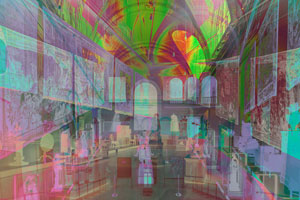James Welling can make photography look like painting or, for that matter, pretty much anything else you like. He cherishes the marks of a photographic print all the same.
Photos for Welling come in all kinds, but they always make an impression. In close-up, orange lilies flare out in all directions, not least toward you. Streaks of yellow and purple might almost have come from a loaded brush, but alongside the precise outlines and vivid green of spores and leaves. They are in a great tradition of painted flowers, but they speak not of death within nature, but of life. Unlike painting within that tradition, from Flemish still life to Cecily Brown to this day, they do not serve as a warning, apart from a warning about painterly or photographic accuracy itself, at David Zwirner. If you leave thinking instead of silkscreen flowers from Andy Warhol, another artist with thoughts of death, you would not be far wrong.
Waves splash up against the picture plane, but they take their color from photocollage. They have the texture of bare canvas or of rocks along the shore. Like a classic seascape, more texturing brings out the blue of the ocean, both up close and up to the horizon. Its horizontals echo the familiar format of a landscape, and sure enough this is a painter’s territory, the Maine coast that drew Winslow Homer to set up his studio and to look again to the sea. The gallery compares it to the gray sea for John Marin as well. It is Welling’s usual UV-curable ink on aluminum nonetheless.
Wooden double doors have their own peeling paint, in a saturated blue that should surely have faded. They, too, insist on the picture plane and the human activity shaping nature. Welling’s landscapes are a built environment, from Cubi, sculpture by David Smith on the Yale campus, to windows set back within concrete cubes for the brutalism of a government center in California. I mistook the layered horizontals of piers and background architecture for an ocean liner. The scenes range across the United States, but they keep returning to the artist’s worktable, often as not outdoors. Stones and fabric in his studio have harsh lines and deep folds that all but insist on brushwork, but they dissolve into the dots of a screen print.
Welling’s mind games are never less than visual, and they give equal attention to the photographic process and to real things. He calls the show his “Thought Objects,” through February 10. They invite one to rethink the artist’s thoughts and the medium. He starts with photographs, but each print is a distinct object and a distinct step in the process as well. One can easily imagine plated loaded with ink pressed and dragged onto aluminum. One can see why he appears at MoMA in a show not of photography but of late modern prints, in collaboration with Jacob Samuel.
 Welling has appeared in all sorts of contexts, as well as in frequent shows at the gallery. He has indulged in abstraction with black quadrilaterals and direct impressions on sensitive paper. He has been part of what Walter Benjamin called the Arcades Project, what the Met called “The Poetics of Place,” and what a gallery called “The Photographic Object.” He has appeared in ghostly color negatives and in washed-out blue in the 2008 Whitney Biennial. He comes closest to his experimental side here with prints that leave much of the paper untouched. All you get is traces of photography that only thus find their way into prints.
Welling has appeared in all sorts of contexts, as well as in frequent shows at the gallery. He has indulged in abstraction with black quadrilaterals and direct impressions on sensitive paper. He has been part of what Walter Benjamin called the Arcades Project, what the Met called “The Poetics of Place,” and what a gallery called “The Photographic Object.” He has appeared in ghostly color negatives and in washed-out blue in the 2008 Whitney Biennial. He comes closest to his experimental side here with prints that leave much of the paper untouched. All you get is traces of photography that only thus find their way into prints.
It is easy to take him for granted, and (as you can see from the sheer number of links), I often have. It is easy enough, too, to dismiss his large prints as pretentious, and they are not. Old standards of beauty, it turns out, get along just fine with the harsh scrutiny of UV light. You can start to ask something that you might have overlooked: in that moment between camera work and the print, is the photo an aim, a process, or a thing in itself? It takes all three to create a thought object.
Read more, now in a feature-length article on this site.
